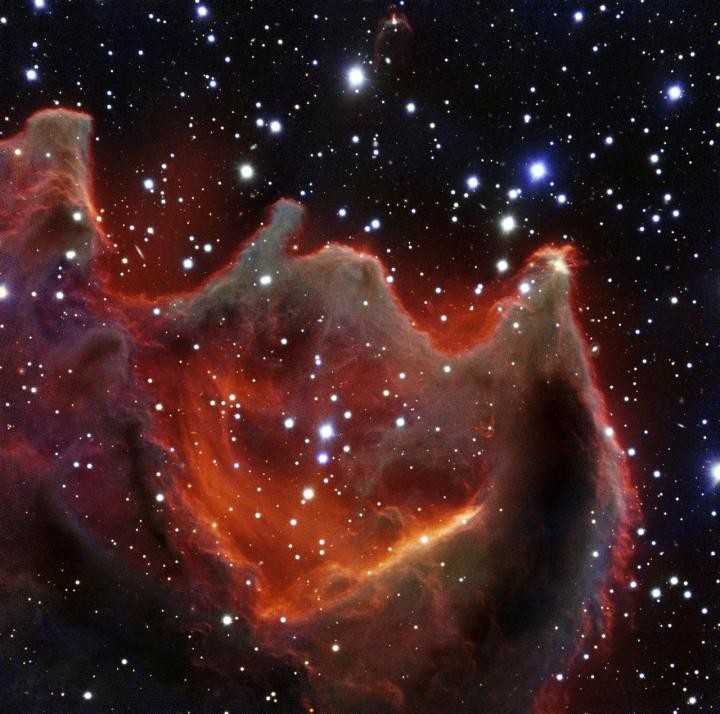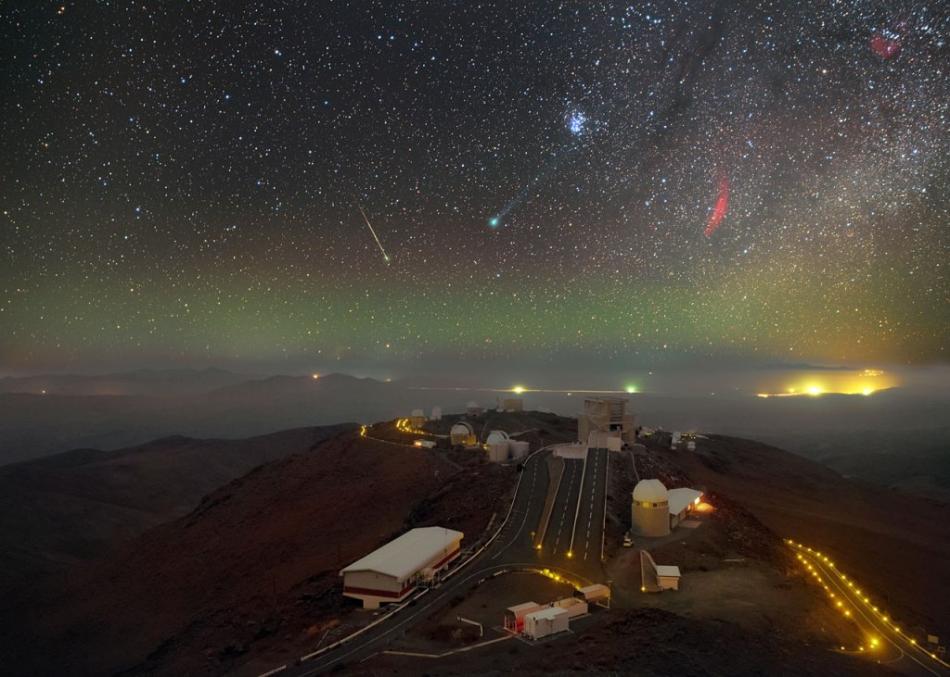February 1 - 7, 2015: Issue 200
Cosmic Gems - ESO's outreach Education Programme
 January 28, 2015 – In 1976 several elongated comet-like objects were discovered on pictures taken with the UK Schmidt Telescope in Australia. Because of their appearance, they became known as cometary globules even though they have nothing in common with comets. They were all located in a huge patch of glowing gas called the Gum Nebula. They had dense, dark, dusty heads and long, faint tails, which were generally pointing away from the Vela supernova remnant located at the centre of the Gum Nebula. Although these objects are relatively close by, it took astronomers a long time to find them as they glow very dimly and are therefore hard to detect.
January 28, 2015 – In 1976 several elongated comet-like objects were discovered on pictures taken with the UK Schmidt Telescope in Australia. Because of their appearance, they became known as cometary globules even though they have nothing in common with comets. They were all located in a huge patch of glowing gas called the Gum Nebula. They had dense, dark, dusty heads and long, faint tails, which were generally pointing away from the Vela supernova remnant located at the centre of the Gum Nebula. Although these objects are relatively close by, it took astronomers a long time to find them as they glow very dimly and are therefore hard to detect.
The object shown in this new picture, CG4, which is also sometimes referred to as God's Hand, is one of these cometary globules. It is located about 1300 light-years from Earth in the constellation of Puppis (The Poop, or Stern).
The head of CG4, which is the part visible on this image and resembles the head of the gigantic beast, has a diameter of 1.5 light-years. The tail of the globule -- which extends downwards and is not visible in the image -- is about eight light-years long. By astronomical standards this makes it a comparatively small cloud.
The relatively small size is a general feature of cometary globules. All of the cometary globules found so far are isolated, relatively small clouds of neutral gas and dust within the Milky Way, which are surrounded by hot ionised material.
The head part of CG4 is a thick cloud of gas and dust, which is only visible because it is illuminated by the light from nearby stars. The radiation emitted by these stars is gradually destroying the head of the globule and eroding away the tiny particles that scatter the starlight. However, the dusty cloud of CG4 still contains enough gas to make several Sun-sized stars and indeed, CG4 is actively forming new stars, perhaps triggered as radiation from the stars powering the Gum Nebula reached CG4.
Why CG4 and other cometary globules have their distinct form is still a matter of debate among astronomers and two theories have developed. Cometary globules, and therefore also CG4, could originally have been spherical nebulae, which were disrupted and acquired their new, unusual form because of the effects of a nearby supernova explosion. Other astronomers suggest, that cometary globules are shaped by stellar winds and ionising radiation from hot, massive OB star. These effects could first lead to the bizarrely (but appropriately!) named formations known as elephant trunks and then eventually cometary globules.
To find out more, astronomers need to find out the mass, density, temperature, and velocities of the material in the globules. These can be determined by the measurements of molecular spectral lines which are most easily accessible at millimetre wavelengths -- wavelengths at which telescopes like the Atacama Large Millimeter/submillimeter Array (ALMA) operate.
This picture comes from the ESO Cosmic Gems programme, an outreach initiative to produce images of interesting, intriguing or visually attractive objects using ESO telescopes, for the purposes of education and public outreach. The programme makes use of telescope time that cannot be used for science observations. All data collected may also be suitable for scientific purposes, and are made available to astronomers through ESO's science archive.
The above story is based on materials provided by European Southern Observatory (ESO). You can find out more, see more of these brilliant images, at: www.eso.org/public/
An example: Celestial Nomad Takes Centre Stage
January 26, 2015 - In this new ESO image, nightfall raises the curtain on a theatrical display taking place in the cloudless skies over La Silla.
In a scene humming with activity, the major players captured here are Comet Lovejoy, glowing green in the centre of the image; the Pleiades above and to the right; and the California Nebula, providing some contrast in the form of a red arc of gas directly to the right of Lovejoy.
A meteor adds its own streak of light to the scene, seeming to plunge into the hazy pool of green light collecting along the horizon.
The telescopes of La Silla provide an audience for this celestial performance, and a thin shroud of low altitude cloud clings to the plain below the observatory streaked by the Panamericana Highway.
Comet Lovejoy’s long tail is being pushed away from the comet by the solar wind. Carbon compounds that have been excited by ultraviolet radiation from the Sun give it its striking green hue.
This is the first time the comet has passed through the inner Solar System and ignited so spectacularly in over 11 000 years. Its highly elliptical orbit about the Sun — adjusted slightly due to meddling planets — means that it will not grace our skies for another 8000 years once it has rounded the Sun and begun its lonely voyage back into the cold outer regions of the Solar System.
This image was taken by ESO Photo Ambassador Petr Horálek during a visit to La Silla in January 2015. The sky in this image was captured with a series of long exposures, resulting in the wonderful vista of the comet in the sky. However, the bottom half uses only one of these exposures in order to retain the sharpness of the La Silla landscape. Credit: P. Horálek/ESO
